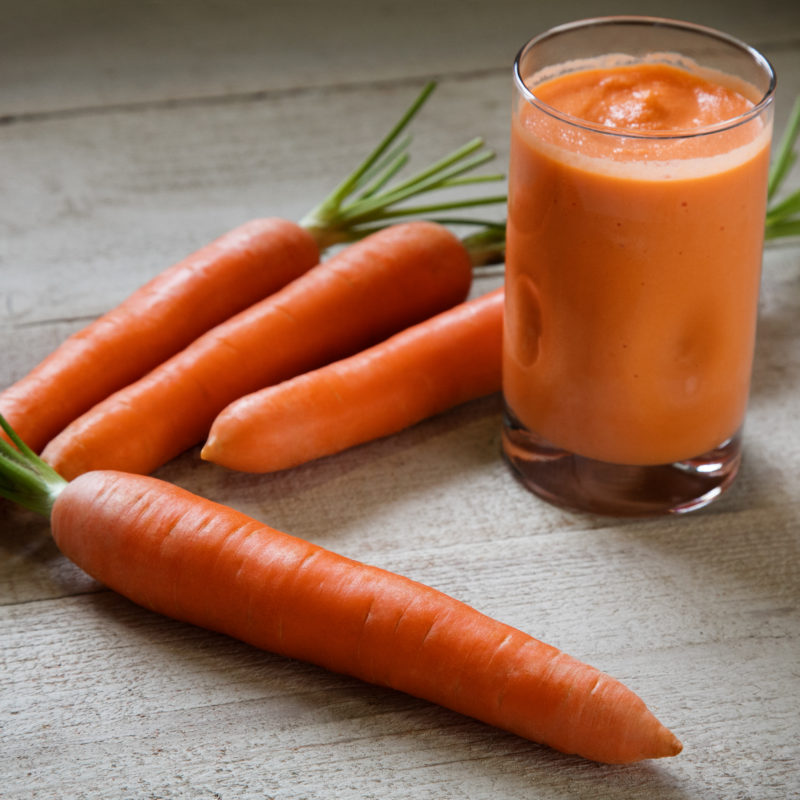Learn these top smoothie tips to inspire customers and boost sales!
Smoothies and juices are healthy for the consumer and for your farm market business! They use large volumes of premium greens, fruit and vegetables that customers need to buy on a regular basis.
by Heather Kibble and Tracy Lee
Smoothies can add some needed servings of vegetables and fruits to our diets. Many vegetables, including leafy greens and roasted squash, are wonderful in smoothies. Leafy green vegetables in general, grow very quickly and do not need much lead time. Your customer will be looking for fresh, bright leaves. Tender baby size leaves are best for blended drinks. Greens and herb leaves should be harvested young and used quickly. Look for new beet varieties grown just for the greens and spinach bred for baby leaf.
Smoothies are a great way to promote the wide assortment of fruit, vegetables, and herbs available. Juicing is easy to do at home as well. Most people think of oranges of course, but all kinds of fruits and vegetables are great for juicing. Apple/Carrot is a healthy favorite and beets are gaining popularity. Beets make a bright, healthy juice with 58 calories and 13 grams of carbohydrates per cup. Melons and berries with a touch of basil or mint are a fantastic summer option. Don’t forget to offer those beet greens for smoothies and remember to remind your customers that the pulp left after the juice is extracted composts beautifully. Shoppers are seeking out no-waste options for the kitchen.
For the Grower:
Produce grown for smoothies and juices will benefit from succession planting so plan accordingly. Leafy greens in general, grow very quickly and do not need much lead time. Baby greens and herb leaves will be eaten raw shortly after they leave your market so treat them accordingly- super clean and fresh is the key. To get you started: Fresh Start is a new beet variety grown just for the greens and Lakeside spinach was bred for baby leaf. Atlas and Polaris are excellent butternut varieties with high yields and uniform, correctly sized fruit. Beet Kestrel has a high sugar content for a sweet juice and provides greens. Swiss Chard Peppermint is eye-catching and easy to grow. Summer juicing will benefit from a widely adapted and productive melon variety such as Honey Brew. Don’t forget basil Italian Large Leaf!
Smoothie Tips to pass on to the consumer:
The key to making smoothies an easy meal option is a little planning. Here is what to do:
• Keep a “bullet” type blender on the counter, near the sink. Have several extra cups so each family member can have their own. Smoothies are the perfect answer for picky eaters since you make one serving at a time.
• Stock up on lots of pumpkins and winter squash! Bake them (halved and seeded) in a pan of shallow water. Peel the cooked fruit and keep the pulp in the fridge and freezer. It is now ready to go for smoothies (and soups and bread).
• Go greens! The fresher the better! There are all kinds of types available and most are great in smoothies. Favorites include baby spinach, beet greens, Swiss chard, herbs and kale. All can be harvested, chopped and frozen into baggies so they are ready to go. Frozen greens are easier to blend.
• Pick your liquids. Non-fat milk, unsweetened soy milk, almond and cashew milks are all good creamy options. Fruit juice tastes good but can add calories quickly so use sparingly. For a tropical flavor use coconut water.
• Pick a thickening base- Most people use about ½ a banana per smoothie. Keep peeled chunks in the freezer. Other good options are non-fat Greek yogurt, nut butters, powdered peanut butter, berries, mango, protein powders and pineapple.
• Customize- Matcha powder, wheat germ, grated ginger, oats, bran, vanilla, cinnamon, nutmeg, and carob powder keep things interesting.
Here are a few smoothie recipes to get you started:
Go Green– Blend together 1/2 a banana, 1 tsp. matcha green tea powder, a few chunks of frozen mango, 1/8 cup frozen kale, a few chopped basil leaves and about ½ cup of cashew milk and a 2 tsp. sugar. Add more milk if it is too thick.
Peanut butter lover– Blend together ½ banana, 1/8 cup squash puree, 1 TBL. Peanut butter or peanut butter powder, 2 tsp. brown sugar or maple syrup, 1 TBL. Wheat germ, a sprinkle of cinnamon, and ½ cup milk.
Pumpkin Pie– Blend together 1 small banana chunk, 1 scoop plain or vanilla protein powder, ¼ cup pumpkin or squash puree, 1 tsp. fresh ginger, and ½ cup milk. For sweetness, you can add 1-2 tsp. sugar, agave, or maple syrup. Top with a sprinkle of pumpkin pie spice and/or whipped cream.
Blending is easier if you start with a little liquid at the bottom of the cup, then add chunkier ingredients, then powders and the rest of your liquid. You want your smoothie smooth!
